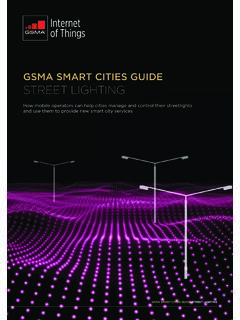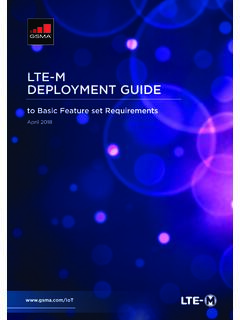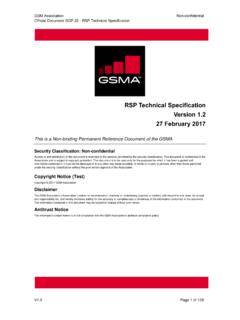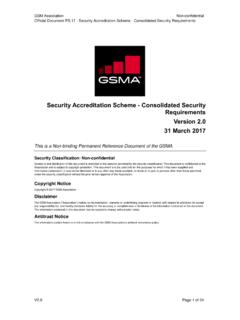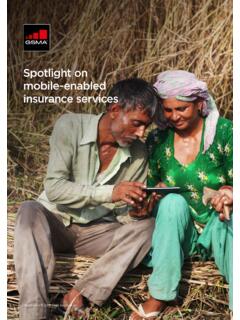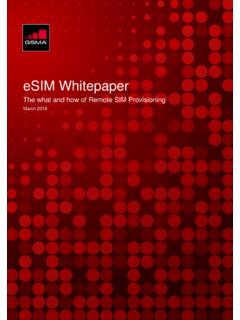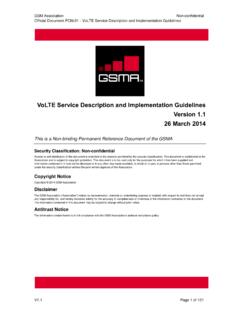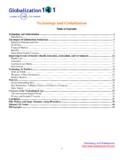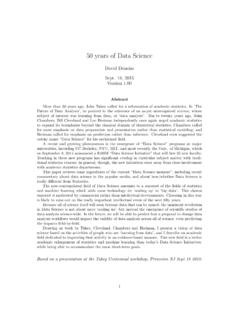Transcription of 5G Spectrum - GSMA
1 5G Spectrum GSMA Public Policy Position March 2021 COPYRIGHT 2021 GSMA5G supports significantly faster mobile broadband speeds and lower latencies than previous generations while also enabling the full potential of the Internet of Things. From connecting vehicles and transforming healthcare to building smart cities and providing fibre-over-the-air, 5G is at the heart of the future of communications. 5G is also essential for preserving the future of the most popular applications like streaming video by ensuring that growing usage can be sustained. Executive Summary 15G SPECTRUM5G goes beyond meeting evolving consumer mobile demands by also delivering carefully designed capabilities that will transform industry vertical sectors. It introduces a new level of flexibility and agility so the network can deliver customisable services to meet the needs of a huge variety of users and connection types.
2 However, the success of the services is heavily reliant on national governments and regulators. The speed, reach and quality of 5G services depends on governments and regulators supporting timely access to the right amount and type of affordable Spectrum , under the right conditions. There is already a significant variation in the amount of Spectrum assigned, and the prices paid at auctions, which means the potential of 5G services will vary between countries. This, in turn, directly impacts the socio-economic benefits of 5G and the competitiveness of national economies. This paper outlines the GSMA s key 5G Spectrum positions, which focus on the areas where governments, regulators, and the mobile industry must cooperate to make 5G a 5G needs significant new harmonised Spectrum so clearing prime bands should be prioritised to meet market demand. Regulators should aim to:- Award at least 80-100 MHz of contiguous Spectrum per operator in initial 5G mid-bands ( GHz) and 800 MHz per operator in initial millimetre wave (mmWave) bands ( 26/28 GHz).
3 - Plan timely significant further allocations and significant subsequent awards in both ranges to help 5G scale as needed. This should include more Spectrum in the GHz range ( GHz), as well as 6 GHz and 40 5G needs Spectrum across low, mid and high Spectrum bands to deliver widespread coverage and support a wide range of use cases. All three ranges have important roles to play: - Low-bands ( sub-1 GHz) support widespread coverage, including indoors, across urban, suburban and rural areas. Increased low-band capacity is required to create greater equality between urban and rural broadband connectivity and address the digital Mid-bands typically offer a good mixture of coverage and capacity benefits. The majority of commercial 5G networks are relying on Spectrum within the GHz range. Other bands which may be assigned to, or refarmed by, operators for 5G include 1500 MHz, 1800 MHz, GHz, GHz and GHz.
4 More Spectrum will be needed to maintain 5G quality of service and meet growing demand in the longer term ( GHz, GHz and 6 GHz). - High-bands support the ultra-high broadband speeds envisioned for 5G ( 26/28/40/66-71 GHz).3. Governments and regulators should support new harmonised bands on the international stage to help 5G services grow over the longer term ( UHF, GHz, GHz and 6 GHz). This includes engaging in the WRC-23 process to ensure sufficient mid- and low-band Spectrum is Exclusively licensed Spectrum over wide geographic areas is vital to the success of 5G. 5. Spectrum sharing and unlicensed Spectrum can play a complementary Setting Spectrum aside for local or vertical usage in priority 5G bands ( GHz) could jeopardise the success of public 5G services and may waste Spectrum . Sharing approaches like leasing are typically better options in these Governments and regulators should avoid inflating 5G Spectrum prices as this is linked to slower broadband speeds and worse coverage.
5 Key concerns are excessive reserve prices, annual fees, limited Spectrum supply ( through set-asides) and poor auction Regulators should carefully consider 5G backhaul needs including making additional bands available and supporting wider bandwidths in existing bands. Measures should also be taken to ensure licences are affordable and designed Regulators should carefully consider the right 5G Spectrum licence terms, conditions and awards approach and consult industry to maximise the benefits of 5G for Governments need to adopt national Spectrum policy measures to encourage long-term heavy investment in 5G networks ( long-term licences, renewal process, Spectrum roadmap etc.). 25G SPECTRUM31. Source: GSMA report: Fixed Wireless Access: Economic Potential and Best Practices (2018) 2. The first industrial revolution is associated with the impact of steam power; the second is linked with science and mass production; and the third was driven by the emergence of digital technology and computing 3.
6 These benefits accrue from large single contiguous blocks as opposed to the same total amount of Spectrum that is aggregated using several separate channels. See vendor s input (entitled Need for contiguous 100 MHz per operator in the 3400-3800 MHz band ) into ECC PT1 meeting #59. Available here: Millimetre wave 5G bands are generally regarded as being 24 GHz and upwards ( 26/28/40 GHz)5. See Coleago Consultings IMT Spectrum demand model in the 2025-2030 timeframe . Available here: 5G SPECTRUMB ackgroundWhat is 5G and how will it be deployed?5G is defined in a set of standardised specifications that are agreed on by international bodies most notably the 3 GPP and the ITU. The ITU has defined criteria for IMT-2020 commonly regarded as 5G and selected a set of compatible technologies which will support the following use cases:1. Enhanced mobile broadband: Including peak download speeds of at least 20 Gbps and a reliable 100 Mbps user experience data rate in dense urban areas.
7 2. Ultra-reliable and low latency communications: Including 1ms latency and very high availability, reliability and security to support services such as VR and connected vehicles. 3. Massive machine-type communications: Including the ability to support at least one million IoT connections per square km with long battery life and extensive wide-area Fixed Wireless Access (FWA): Including the ability to offer fibre type speeds to homes and businesses in rural and urban areas in developed and developing offers a far greater range of capabilities from the outset than any previous mobile technology generation. As a result, 5G not only meets the evolving requirements of consumers, but can also have a transformative impact on businesses to the extent that it is being hailed as vital to the so-called fourth industrial revolution .2 5G is expected to underpin and enable many of the components of this revolution including the Internet of Things, cloud computing , cyber-physical systems and cognitive computing .
8 From automated industrial manufacturing and autonomous cars to a vast array of connected machines and sensors, 5G enables smarter and more efficient businesses and industry vertical sectors ( utilities, manufacturing, transport etc).Advanced 5G features such as end-to-end network slicing and mobile edge computing help support the needs of industry vertical sectors. Network slicing allows services to be precisely tailored to the needs of an organisation in terms of required quality of service, speed, security, latency etc. Edge computing brings compute capabilities closer to consumers and enterprise end users which can enable very low latencies and customised local services. 5G will be delivered over wide areas through the public macro mobile network as well as via localised public and private small cells. Public and localised private 4G and 5G networks are already provided today by mobile operators but others can build such networks using unlicensed Spectrum or by gaining access to licensed Spectrum .
9 However, the capabilities of all these services are dependent on the type and amount of the Spectrum used. Some features like super-fast broadband and very low latencies cannot be provided in a single 5G band as their radio resource requirements are incompatible so can require multiple bands. How much Spectrum does 5G need?The 3 GPP s 5G New Radio (NR) specification includes traditional mobile bands as well as newer, wider bands designed for 5G. It supports channel bandwidths ranging from 5 MHz to 100 MHz for bands below 6 GHz, and channel sizes from 50 MHz to 400 MHz in bands above 24 GHz. The full capabilities are best realised through the widest channel sizes in new 5G bands. 5G supports carrier aggregation to enable very high speeds, however, making Spectrum available in the largest contiguous blocks possible supports faster, lower latency and greener 5G The ITU s minimum technical requirements to meet the IMT-2020 criteria1 and thus the fastest speeds specify at least 100 MHz of bandwidth per operator.
10 They also specify support for up to 1 GHz per operator in bands above 6 GHz such as mmWave research shows significantly more Spectrum will be needed to help 5G services scale in the 2025-2030 timeframe. For example, it has been estimated that an additional 1-2 GHz of mid-band 5G Spectrum could be needed to help ensure mobile networks are capable of delivering the IMT-2020 target of 100 Mbps per user in densely populated urban areas and to support FWA more This is in addition to initial 5G mid-bands ( 400 MHz in GHz) and assumes other mid-bands formerly used for 2G, 3G and 4G services are upgraded to 5G. What Spectrum are regulators making available for 5G and how?Regulators have assigned 5G Spectrum in three broad ranges: high bands ( mmWave) which support the fastest 5G speeds; mid bands ( 1-10 GHz) which offer a good mixture of coverage and capacity; and low bands ( below 1 GHz) which help provide strong wide area and in-building coverage.

